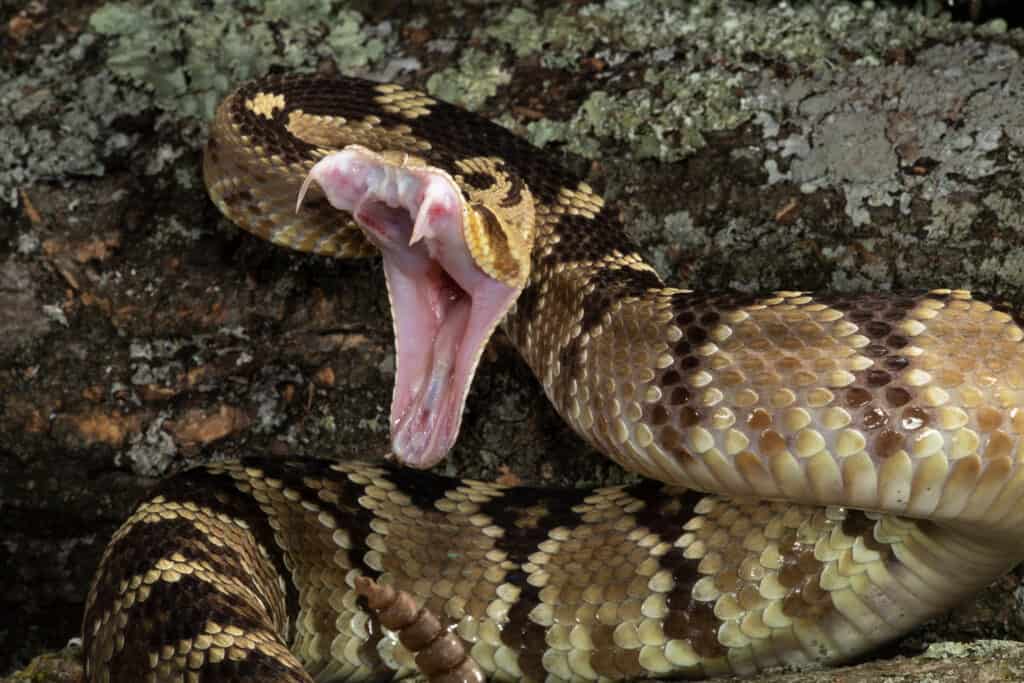Rattlesnakes are one of the most dangerous and deadliest snake species out there. They come from the subfamily Crotalinea, also known as ‘pit vipers.’ Rattlesnakes are well-known predators, and they are also known to attack humans when threatened. These scary snakes exist in many habitats feasting on birds, rodents, mammals, and other animals.
With how active their mouths are, you might wonder what kind of teeth they have, if they have fangs, and how painful their bites can be. There is so much to learn about the teeth of a rattlesnake, let’s dive in!
Do Rattlesnakes Have Teeth?

Rattlesnakes have polyphyodont teeth.
©Maria Dryfhout/Shutterstock.com
Like all pit viper species, rattlesnakes have solenoglyphous dentition – the presence of teeth coupled with fangs as their venom delivery system. These fangs are short and hollow and sometimes retract into the jaw and flip to stab the prey. The venom glands of rattlesnakes are well developed; venom is delivered to the fangs through the ducts, and the venom flows through the solenoglyphous fang like a straw into the bitten part of the prey. These fangs are hinged and fold flat against the roof of the mouth they are not needed. When the snake strikes, its fangs come out and can inject venom deeply into their prey.
What Are Rattlesnake Teeth Made Of?

Like all reptiles, rattlesnake teeth are made of pulp, dentin, cementum, and enamel.
©Joe McDonald/Shutterstock.com
Rattlesnakes have teeth like every other reptile. And reptile teeth are made of pulp, dentin, cementum, and, of course, enamel, just like mammalian teeth. Rattlesnakes have polyphyodont teeth; which means that they can lose and regrow their teeth. Adult rattlesnakes shed their fangs every 6-10 weeks.
What Do Rattlesnakes Eat?
Rattlesnakes are carnivores. These venomous snakes prey on birds, reptiles, amphibians, insects, and many small mammals. They are ambush predators that lay in hiding for their unsuspecting prey before attacking them with their venomous fangs. They use their venom to digest food before swallowing. Even though they often prey on smaller animals, they also attack larger animals when they feel threatened.
Which Rattlesnake Has The Longest Fangs?

The rattlesnake with the longest fang is the eastern diamondback rattlesnake.
©iStock.com/Paulo Almeida
Followed by the gaboon viper, the eastern diamondback rattlesnake has the second longest fangs in the world. Ultimately, the eastern diamond rattlesnake is the rattlesnake with the longest fang. They have fangs about an inch long. These rattlesnakes generally have a small body with an average size of 4 inches, hence they have a significantly large fang-to-body ratio. With their long fangs, they can deposit large venoms into their prey.
Can Rattlesnake Teeth Harm Humans?
Rattlesnakes inflict sharp bites that feel like a sting. After a rattlesnake bite, victims often feel a burning, painful and tingling sensation. There might be slight bruising, discoloration, or swelling at the bite spot. A bite from a rattlesnake is considered a medical emergency. Rattlesnakes are highly venomous, and the bites are dangerous and can be fatal if not attended to immediately.
The venom from a rattlesnake is hemotoxic which means that they contain toxins that can harm the red blood cells, stop blood clotting, damage body organs and tissues, and cause them to degenerate. The rattlesnake venom immobilizes and disables prey.
What To Do When Bitten By a Rattlesnake?
Having established how dangerous a rattlesnake and its bite can be. Our first instinct would be to avoid contact with a rattlesnake. However, if you are unfortunately bitten by one, what should you do?
First, you need to note the symptoms. It can be numbing in the face and limbs, weakness, lightheadedness, drooling, blurred vision, and many other sore feelings. You need to understand that these symptoms would be associated with the sting at the site of the bite.
Secondly, try to identify the particular snake that bit you. Don’t chase it down, as it can strike again. But noting its anatomy would help the medical team with the right treatment for you.
After this, you should contact an ambulance.
But while you wait, here are a few first aid tips to follow
- Do not drink alcohol or take any blood-thinning painkillers.
- Keep the wound below the level of your heart.
- Remove any tight clothing or jewelry.
- Try to reduce movement as much as possible.
- Do not suck out the wound or try any other ineffective way of removing the venom. Just try to get to the hospital as soon as possible.
The photo featured at the top of this post is © iStock.com/DaveGartland
Discover the "Monster" Snake 5X Bigger than an Anaconda
Every day A-Z Animals sends out some of the most incredible facts in the world from our free newsletter. Want to discover the 10 most beautiful snakes in the world, a "snake island" where you're never more than 3 feet from danger, or a "monster" snake 5X larger than an anaconda? Then sign up right now and you'll start receiving our daily newsletter absolutely free.
Sources
- National Parks Service, Available here: https://www.nps.gov/cabr/blogs/fang-tastic-friends.htm
- Healthline, Available here: https://www.healthline.com/health/rattlesnake-bite#treatment
Thank you for reading! Have some feedback for us? Contact the AZ Animals editorial team.






